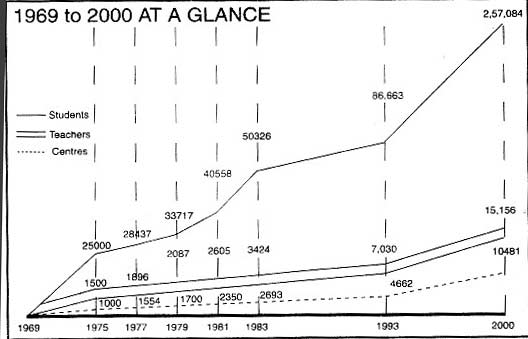
THE QUESTIONABILITY OF THE SSEHV STATISTICS
Sergey Badaev
January, 2005
SSEHV stands for the Sathya Sai Education in Human Values Programme, which is currently the basis of the educational activity of the Sathya Sai Organisation (SSO). The educational activity of the SSO started in 1969 when the educational wing of the SSO was created as an outcome of the 3rd All India Conference at Prashanthi Nilayam, the main Sathya Sai Baba ashram in India. At the very beginning the programme was focused mostly on devotees' children and was known as the Bal Vikas programme, but later it was spread even to public schools under the name of EHV.
Despite the fact of the long history (over 30 years since 1969) and regular reports sent from Sai centres to the Central Office of the SSO, the information on the development of the educational activity of the SSO is rather scarce. This article is based mostly on the special issue of the Bal Vikas magazine published by Sri Sathya Sai Bal Vikas Education Trust on the occasion of the 75th birthday of Sathya Sai Baba in 2000. In the preface Mrs Sarla I. Shah, a Joint Central Co-ordinator of the SSO, writes: "And now comes the important prophesy from "Earth changes Report" - San Francisco that "The education system as we know it will go through a major transition by 2005-2006. A global committee, developed by non-educators and educators alike will conduct a study on education, the result of which will be a proposal for new ways to educate our children. Great insights will come out of this, as a Spiritual Master now living in India, brings forth a new teaching process". As if in support of this prophesy, Bhagavan (=SSB) has blessed world body of Education UNESCO to hold a International Conference of World Educators, on "Human Values Education" at Prashanthi Nilayam in September, 2000".
The conference which had been planned to become a sort of a breakthrough for world wide recognition turned to be a complete failure and fiasco, when UNESCO and Flinder's University which were co-organisers of this conference withdrew from any participation. Moreover UNESCO published a Media Advisory, which among the other reasons mentions that "the Organization is deeply concerned about widely-reported allegations of sexual abuse involving youths and children that have been levelled at the leader of the movement in question, Sathya Sai Baba". (http://saiguru.net/english/news/000915unesco.htm)
Nevertheless this magazine issue is valuable because it gives us a rare example of statistics concerning quantitative growth of the educational activity of the SSO. These statistics were reproduced in the daily newspaper THE HINDU, September 25, 2000 (p.15).

Unfortunately, neither the magazine issue, nor THE HINDU gives any explanations
of the figures. It is supposed to be the statistics for India only as the term
Bal Vikas has been used mostly for India. However there is a clear discrepancy
between the figures demonstrated in the graph and those presented in one of the
articles in this magazine. Dr B. G. Pitre mentions in his article (p.16): "By
1979 it (=Bal Vikas) had practically spread to every district of India. Over
50,000 children were receiving education under 3,400 trained teachers". At
the same time according to the graph in 1979 there were over 33,000 students and
2,000 teachers in Bal Vikas. This example shows us a typical inaccuracy in the
Sai Movement when it comes to numbers. Factual and number accuracy is a basic
element of the scientific culture. But this inaccuracy is not surprising if we
take into account that the SSO only follows in this respect its spiritual
leader, Sathya Sai Baba, who often exaggerates numbers see here and neglects facts
(http://bdsteel.tripod.com/More/storyhijack.htm).
Another interesting point can be revealed when we look at the years presented in the graph. From 1975 to 1983 the data are given for every other year. After that, the data are given only for 1993 and 2000. I am afraid that it might have a specific reason. In the article of Dr B. G. Pitre (p.17) we can read: "By 1989, thousands of teachers were trained and hundreds of schools had adopted the new curriculum in India. Several State Governments and agencies had accepted this programme. There was no doubt that a certain amount of euphoria was created in India over the rapid pace of the EHV programme. At that exact moment Baba asked the programme to be halted in India". Dr Pitre gives no details or explanations of what kind of halt that was. Doesn't he do that because of lack of knowledge or as a result of censorship (self-censorship)? It may be well suggested that this event might be connected with the abolishing without any clear reasons of the World Council in 1987, 12 years after its inception in 1975. So, the simple reason for such a presentation of the data in the graph might be to pretend a constant increase of numbers and cover up a possible fall after 1989.
If our guess is true then we have another example when facts are sacrificed for the sake of an image and myth. I think this is a completely wrong model for value education and educators. But this can be easily justified by Sathya Sai Baba's devotees, as their guru, who proclaims himself an Avatar, repeatedly hammers into his devotees' mind: "Past is past, forget the past" (see for example discourse 18.02.2004). That is a very comfortable approach which lets them pretend there were no bloody murders in Sathya Sai Baba's bedroom in 1993, no sexual molestations of young male devotees, no fake lingam productions and materialisations, no unfulfilled promises and so on.